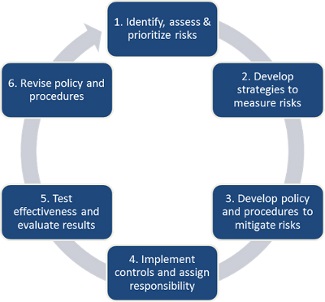Body-worn cameras (BWCs) are rapidly being deployed in police departments around the country. These deployments come with a host of expectations, as well as challenges. Departments shouldn’t overlook, or underestimate, the simple premise that the day the first BWCs are deployed they begin to document department operations, policy, practices, and training in a detailed manner not previously possible. This documentation places a responsibility on the department to identify, correct and evaluate shortcomings in their BWC initiatives. Nowhere is this more important than in all aspects of use of force. BWCs can be a vital tool in monitoring use of force. Departments should consider implementing a risk management feedback loop to accomplish this task.

The Business of Government
Risk management is a process that can be used to deal with risks associated with operations—in this case, use of force. A general risk management feedback loop contains the six steps indicated in the diagram to the left. This model provides a decision-making tool to increase agency effectiveness by identifying, assessing, and managing risks. It allows for informed decisions and minimizes risks.
Traditional use of force documentation has its limitations. Its qualitative value is largely dependent on standardized data collected and the self-reported detail provided by officers in narratives. This level of documentation is generally inadequate to support a robust risk-management process. BWCs, however, can provide a wealth of detailed observational information that makes the documentation process especially effective. Consider a typical minor use of force report where a suspect sustained a cut on his forehead while being taken to the ground by an officer. In a traditional written report, the officer may state that the suspect was argumentative, resistant to commands, and became combative when being placed into handcuffs. In response, the officer used a department-authorized takedown technique that resulted in the injury.
The vast majority of officers don’t have the time or the specific knowledge to use the detail necessary for an effective risk-management appraisal. How argumentative was the suspect? How loud? What did his body language, his facial expressions suggest to the officer? How resistant was the suspect? Just exactly how was the resistance exhibited? Did the officer miss an opportunity to de-escalate the encounter? BWCs can provide extensive visual detail that can be analyzed, in conjunction with written reports, to form a qualitative base of information that can serve as the foundation for an effective risk-management process. The camera can capture the threatening vocal tone and volume of the suspect and the officer. It can capture those indicators every officer is taught to look for as precursors to a fight—the little things that many times get lost when trying to convey an incident in writing. Yet this innovation must be tempered with the acknowledgement that BWCs may not always capture what is needed, and that what is captured many times will need to be evaluated with written reports to get a complete accounting of the incident.
A process for gathering use of force data and its accompanying BWC recordings must be established before a department can implement a risk-management loop process. How this is done, and how often it is done, can be a particularly controversial issue among officers, police unions, and department management. An open discourse among all parties is essential, and the process must be clearly documented and closely managed. The process cannot be seen as a “fishing expedition” for misconduct but, rather, a process to correct shortcomings in officer behavior, training practices, policy, or procedures. Excessive use of force, abuse or misconduct cannot be tolerated, but applying discipline for minor infractions would be counterproductive. In contrast, departments should not want to risk losing the corrective opportunities provided by BWC recordings especially when it could have prevented a high profile use of force incident.
The risk-management loop can be effectively utilized once the process of collecting use of force data and associated BWC recordings has been established. Ultimately, the goal is to implement a process that will improve a department’s management of use of force. In future installments of In View commentary, we will discuss each step of this loop in more detail.
Lt. Dan Zehnder is currently assigned to the Las Vegas Metropolitan Police Department’s Project Management and Video Bureau where he serves as the Body-Worn Camera (BWC) Program Manager and is responsible for all aspects of planning, operations, and management of the program. Dan is also project manager for the 400 officer BWC efficacy study currently being conducted by CNA Corporation for the National Institute of Justice.
Dan has been with the Las Vegas Metropolitan Police Department for 20 years. Prior to that, he was as an enlisted soldier, non-commissioned officer and officer in the United States Army for 21 years. He served in intelligence, special operations, and armor assignments. He ended his career with assignments as a staff officer on the Department of Defense Joint Staff and in the Office of the Chief of Staff of the Army.
References/Further Reading
Walker, S., and C.A. Archbold. 2014. The New World of Police Accountability. Second Edition. Thousand Oaks, CA: Sage Publications.
Hardy, K. 2010. Managing Risk in Government: An Introduction to Enterprise Risk Management. Second Edition. Financial Management Series. The IBM Center for The Business of Government.
This project was supported by Grant No. 2015-DE-BX-K002 awarded by the Bureau of Justice Assistance. The Bureau of Justice Assistance is a component of the Department of Justice's Office of Justice Programs, which also includes the Bureau of Justice Statistics, the National Institute of Justice, the Office of Juvenile Justiceand Delinquency Prevention, the Office for Victims of Crime, and the SMART Office. Points of view or opinions in this document are those of the author and do not necessarily represent the official position or policies of the U.S. Department of Justice.

How Body-Worn Cameras Can Allow Police to Apply a Risk Management Lens to Use of Force